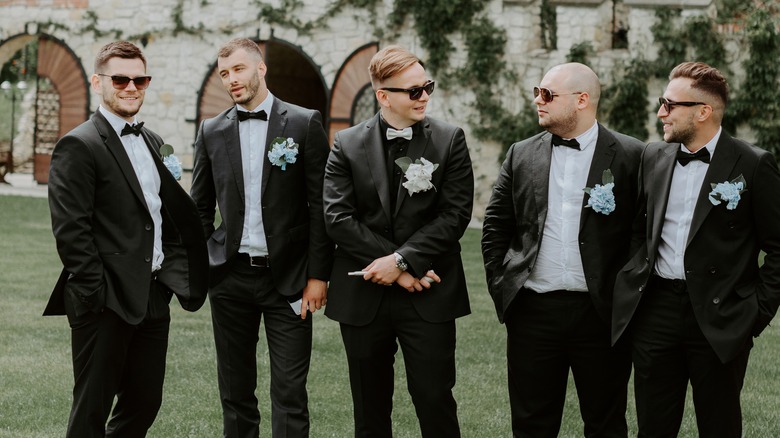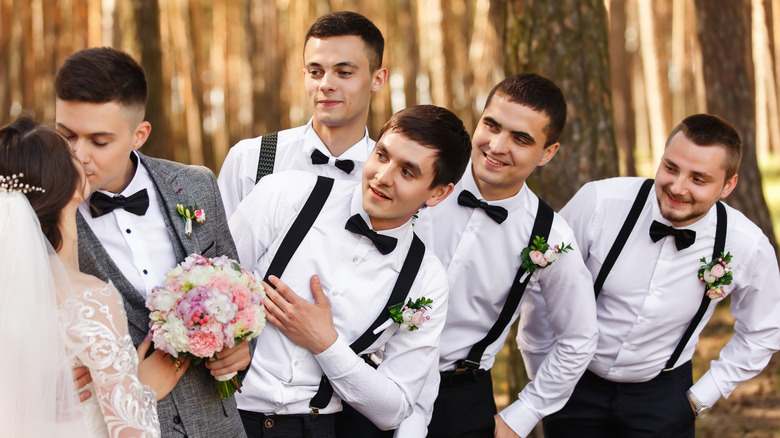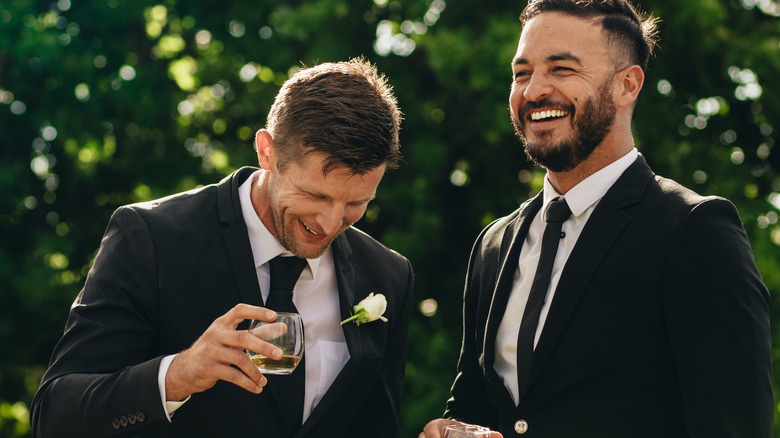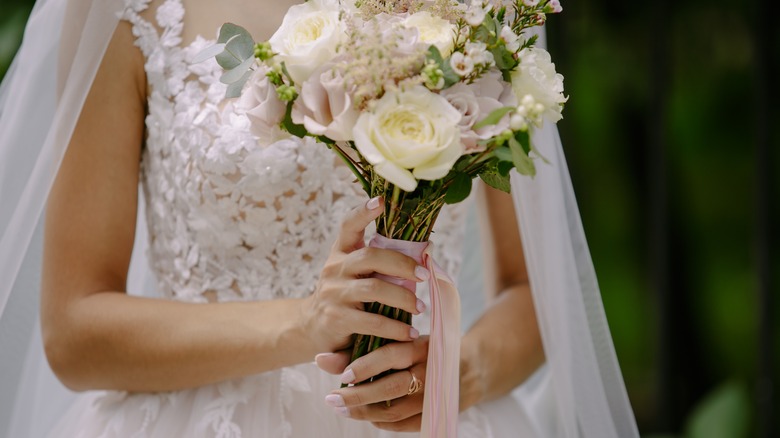The Origins Of Groomsmen At Weddings Are Not What We Expected
There are so many wedding trends and traditions to sift through when deciding which ones you want to participate in on your special day. But have you ever wondered where those traditions actually come from?
Two people joining in matrimony is a tradition that is thousands of years old, with the first evidence dating back to ancient Mesopotamia in 2350 B.C. Love wasn't actually the reason for most marriages – weddings were often looked at as a transaction of wealth and goods between families. It was also used as a way to keep bloodlines "pure," in the case of royalty. For centuries, brides were merely viewed as property exchanged between a father and a groom. The harder you look, the more you will find that most wedding traditions were actually pretty problematic.
Because of this, many modern brides have decided to forego things like the bouquet and garter toss, or opted for a more updated version of their wedding vows. After all, "to honor and obey" doesn't exactly have the same ring that it once did. But one of the traditions you probably haven't second-guessed is your wedding party. Having your best friends and loved ones standing beside you while you say "I do" to the love of your life sounds like the perfect way to begin a marriage. But just like most wedding traditions, your groomsmen used to have a bigger role to play than getting your soon-to-be-hubby drunk at his bachelor party.
Groomsmen had some pretty problematic responsibilities
Nowadays, you might ask your groomsmen for a few favors before the wedding day, but have you ever considered asking them to kidnap your fianceé? Centuries ago, it was pretty much a requirement for the groomsmen to become kidnappers, and steal the groom's intended from her home. This was known as "marriage by capture", and most of the time, it was not exactly consensual. In cases where the bride and groom were very much in love, but her family didn't approve, groomsmen were known more valiantly as the "bride's knights" and would retrieve her from her home and escort her to her wedding ceremony. This would often lead to a physical fight between the bride's family and the groomsmen, who were ready to brawl on their friend's behalf.
So while you're deciding who you'll ask to be your groomsmen, consider which of them would fight for you if given the chance – although we hope none of you are considering which ones would be good at kidnapping.
When choosing your best man, make sure he's good with a sword
Being a best man is a high honor at modern weddings – usually, the groom asks his closest friend, brother, or a trusted loved one to stand beside him, assist with pre-wedding festivities, and even speak during the reception. But the role of best man used to be much more dangerous back in the day.
Some historians believe that the best man tradition dates back to 16th century Scotland, when men would choose a bride amongst the women in their small village. But there always seemed to be competition for the bride's hand, so the groom would enlist the best swordsman he knew to protect him during the ceremony. The best man would stand on the groom's right-hand side with a sword, ready to draw if anyone tried to challenge the groom during the ceremony. It is still a tradition for the best man to stand to the groom's right-hand side, although they probably leave their swords at home nowadays.
Worried about evil spirits? Find some groomsmen!
Weddings are famous for their superstitious traditions. Even to this day, couples think it's bad luck to see each other on the morning of their wedding, and finding something old, something new, something borrowed, and something blue is on the top of the bride's to-do list. But no one was more superstitious than the Ancient Romans, who took extra measures to ensure that the bride and groom were safe from evil spirits on their wedding day. They required 10 witnesses to be present at a wedding ceremony, which is most likely where the origins of bridesmaids and groomsmen come from.
These 10 witnesses were extra special to the couple, but they also had a serious job to do: shield the couple from evil spirits. It was believed that evil spirits would attempt to sabotage and destroy weddings, usually in the form of harming the bride or cursing their "marital bed." In order to protect the bride and groom, bridesmaids and groomsmen would disguise themselves as the happy couple by wearing the same attire. This was believed to confuse the evil spirits and protect them from harm. The trickery also worked well if another suitor crashed the ceremony, looking to steal the bride (and her dowry) for himself. This is believed to be one of the origins for groomsmen attire, which highly resembles the groom even to this day.
Believe it or not, bachelor parties used to be way less scandalous
The "last night of freedom" mindset that modern grooms and groomsmen celebrate at a bachelor party actually derives from a Spartan celebration in 5th century B.C.. Unlike the rowdy shenanigans we imagine today, the Spartans would host a formal celebration for the groom on the night before his wedding, enjoying a large feast and giving speeches.
These days, when you think of a bachelor party, what comes to mind? Maybe a trip to Vegas, stopping into a strip club, and definitely a lot of heavy drinking. If you've ever seen "The Hangover," you know just how crazy a bachelor party can get. While this type of celebration might give the bride-to-be some pause, considering that some grooms view their bachelor party as one last night to hook up with someone other than their partner, there are plenty of unique bachelor party ideas that break the stereotype of drunken debauchery and next-day regrets. Think, what would the Spartans do?
More wedding traditions with seriously weird origins
Having groomsmen isn't the only wedding tradition with a storied history. When you're deciding which traditions to partake in on your special day, consider where they came from. Brides who throw on a veil on their wedding day view it as a fashion statement, but centuries ago, veils were used to shroud the bride from evil spirits that tried to harm her. It also served as a face covering for arranged marriages, hoping to secure the groom's "I do" before he saw her face and changed his mind. Super harsh, but it did happen.
Holding a bouquet wasn't always used for the sake of accessorizing, either. Brides were instructed to hold bundles of potent herbs and flowers in an attempt to mask her body odor – before indoor plumbing, most people didn't bathe all that often, making for a pretty stinky ceremony.
From carrying the bride across the threshold to ringing bells on the wedding day, there is a problematic past for pretty much every wedding tradition. So next time you find yourself garter shopping, do yourself a favor and Google it first.





